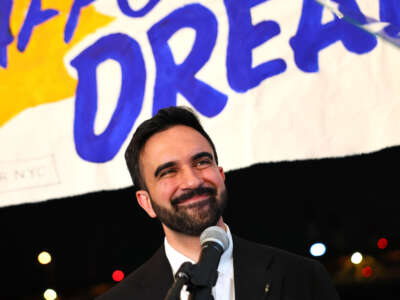Support justice-driven, accurate and transparent news — make a quick donation to Truthout today!
By now, much ink has been spilled and many takes have been shared on the resounding 12-point victory of Zohran Mamdani over former Gov. Andrew Cuomo last Tuesday in the New York City primary to become the presumptive Democratic nominee for mayor. There are many reasons for this win, including Mamdani’s talents; his clear progressive message focusing on affordability in one of the most expensive cities in the country; and his excellent use of social media, earned media, and traditional ads.
Mamdani’s plans were almost immediately denounced as “unrealistic” and pie in the sky by political commentators. The Atlantic suggested that his accessible, unified message of affordability — with key policies, such as free child care, free bus service, and rent freezes for New York City’s 2 million rent-stabilized tenants — was a form of “magical realism.” Pundits and political elites repeatedly claimed that such universal affordability type policies did not speak to voters of color, but rather only appealed to highly educated white younger voters. Underlying the tired trope of the socialist “Bernie Bro” was the implicit idea that Mamdani’s voter base would be limited only to college-educated transplants, out of touch with the experience of working-class communities of color.
Despite nearly universal opinions and polling data predicting a Cuomo victory, the underdog’s victory last week revealed many of his advantages. Commentators have pointed to a plethora of explanations — Cuomo’s toxicity and scandals, as well as Mamdani’s charisma, political talent, clear messaging, and excellent social media strategy and ground game. The City called his tens of thousands of volunteers Mamdani’s “army,” and according to the campaign, canvassers knocked on over 1 million doors.
Stay in the loop
Never miss the news and analysis you care about.
All of these factors undoubtedly contributed to Mamdani’s win, but these were obvious factors prior to his upset victory. One factor of Mamdani’s campaign that gets less attention is its grassroots nature, which goes beyond merely running an impressive ground game door-knocking operation; Mamdani’s campaign is grassroots in its origins, its associations, its practice, and its theory of governance. The media does not quite understand this orientation, because most candidates and politicians are so divorced from the grassroots. The clarity of Mamdani’s message and his unique talent may serve as an inspiration for other insurgents, as might his grassroots commitments.
While Mamdani’s affordability agenda was mocked as unrealistic, and even out of touch with the working-class communities he needed to win the primary, this narrative ignores his “man on the street” style of campaigning that he began following Donald Trump’s general election victory in November 2024. Specifically, Latino voters in the Bronx and Asian voters in Queens noticeably broke for Trump, compared to their voting behavior in 2020. Shortly after the 2024 election, Mamdani spoke with voters in the Bronx and Queens about why they chose to vote for Trump (or chose not to vote) and recorded their answers. The voters gave different responses: affordability, problems with the system, rent and food costs, general disappointment in the Democrats, and Israel’s U.S.-backed genocide in Gaza. Absent were mentions of disliking immigrants (as these neighborhoods are diverse and immigrant heavy) or other so-called “woke” issues. Rather, this video captured a bottom-up desire for Democratic politicians to respond to people’s immediate economic needs.
Mamdani’s messaging came from countless conversations like the ones in the video. His unified message of affordability, universal programs, and solidarity wasn’t just popular — it was also digestible and easy to understand. In response, Cuomo came prepared with a well-funded media campaign backed by super PACs, blanketing the airwaves with anti-Mamdani commercials and filling mailboxes with mailers, spending a record-breaking $25 million. But all this propaganda, which characterized Mamdani as dangerous and inexperienced, did not work. And part of this is because of the strength of the grassroots efforts, which went beyond canvassing.
Aaron Fernando is a member of New York City’s chapter of Democratic Socialists of America (DSA), a law student, and a volunteer for Mamdani’s campaign. Fernando told Truthout, “With an electorate as large as New York City’s, paid media like TV advertisements and mailers can get a campaign pretty far. And after [Kamala] Harris lost every swing state [in 2024] despite a gigantic field operation, many people declared that canvassing had become obsolete. But that’s the wrong message to take away.”
The truth, Fernando says, is that while canvassing alone can’t win large-scale elections, it can reinforce the messaging a campaign puts out and allow voters to “make the connection between the information about the candidate they’ve been hearing [about] and the smiling canvasser at their front door.” Canvassing can also reach unique populations, Fernando says, “like the Muslim and South Asian uncles and aunties that powered Zohran’s victory.”
“Make no mistake,” Fernando concluded. “Zohran’s operation of 50,000 volunteers and 1.5 million doors knocked — the end result of almost a decade of NYC-DSA’s trial-and-error on our campaigns — was the difference in this election.”
In addition to the canvassing operation, Zohran Mamdani’s campaign maintained strong connections to left and progressive political organizations, such as the Working Families Party, the New York City chapter of DSA, and youth climate organizations, such as TREEage and the Sunrise Movement. Many of these organizations endorsed early and provided the volunteer muscle to share the campaigns’ message among diverse networks. The Mamdani campaign came out with its three key policies — free child care, buses, and rent freezes — but developed other policy platforms through collaboration with policy experts and grassroots organizations, many of which are grassroots Black and immigrant community-based.
Mamdani’s dedication to openness, collaboration, and shared goals permeated his campaign. “A profound democratic sensibility extended through every aspect of the Zohran campaign — from the platform that focused on the issues that keep millions of working New Yorkers up at night; to the role played by millions of canvassing conversations with strangers about how to change our city; to the way that everyday people who had never been involved in politics before could get involved, build their skills, develop the campaign’s strategy together, and become leaders,” Mamdani campaign volunteer Jeremy Cohan told Truthout.
“It’s no wonder the establishment completely dismissed it, because it is totally foreign to how they operate, which is fundamentally based on treating working people as passive consumers to whom experts try to sell a political product dreamed up in a boardroom with millionaire and billionaire donors,” Cohan said. “Rather than catering to big donors, corporate consultants, and bloviating pundits, [the campaign] starts from the basic belief that most people in our society are made to feel powerless, that this is the basis of tremendous suffering — not to mention of fascist reaction — and that democracy must enfranchise and involve ordinary people on a deep level in taking control of their lives, their society, and their future.”
This message of hope and empowering everyday people, whether in their interactions with the mayoral candidate or through conversations with volunteers, created a stark contrast with the politics of fear and distrust that characterized the Cuomo campaign.
But perhaps the characteristic of the Mamdani campaign that is least understood by both professional pundits and Democratic leadership alike is the radical model of governance that informed Mamdani’s tenure as an assemblymember, which has also been present in his campaign thus far. As part of the Socialist in Office co-governance committee, Mamdani, together with other socialist state legislators and city council members, has taken a social movement approach to governing, building power through mobilizing and empowering regular people to push for solutions at all levels of government. A 2022 article from The Nation noted how Mamdani helped constituents organize to solve municipal-level problems like requesting a traffic light at a busy intersection, even though he is a state-level legislator, because he treated constituent services as a way to build power and democratize local government. Even though the theory of change behind this co-governance model was clearly laid out in the article, somehow this grassroots-oriented model of political power remains incomprehensible to most political observers.
Mamdani was constantly dinged on only passing “three bills” during his time in the legislature and he never defended this record. Instead, he continued to stress his social movement, grassroots orientation to prove his effectiveness as an elected official, pointing out his organizing with indebted taxi drivers and their advocacy group, in which he engaged in a 15-day hunger strike to negotiate for city debt relief for taxi drivers. While not carrying any bills on eviction protections, working with housing activists, he was arrested for protesting the end of the COVID-era eviction moratorium in 2021. This broader movement helped pass historic “Good Cause” eviction protection in New York State in 2024. In collaboration with the Public Power campaign and DSA Ecosocialists, Mamdani and other DSA electeds rallied, marched, and organized to fight for New York’s Build Public Renewables Act in 2023, touted as the country’s biggest climate law. The legislation allowed for the building of publicly owned renewable energy infrastructure, although Mamdani was not listed as the bill’s main sponsor. This is a non-comprehensive list that only scratches the surface of the grassroots governance that characterized Mamdani’s time in the New York State Assembly. Rather than see himself as a politician at the top, this theory of governance sees electeds as playing an inside-outside strategy, clearly embedded in grassroots and social movements.
Mamdani’s fellow socialist in office, New York State Assembly member and housing activist Marcela Mitaynes, told Truthout that the goal of the campaigns and socialists in office is to build movements and organizers, not just one-time voters and constituents. “[Current New York City Mayor Eric Adams] said, ‘Oh you can’t have free buses, you can’t tax the rich. That’s on the state level.’ But he doesn’t understand how [our project] works. We are building the political community. …We are teaching people to do more and go beyond the typical political script,” Mitaynes said.
“In this next stage of the campaign, we’ll be able to build that and that talk about governance and how it works, and then we’ll be able to pass this legislation. This grassroots organizing means we can push people — city council members, state legislators — to pass the laws we want,” Mitaynes said. “To [most politicians], everything is transactional. You either have the political capital to do it or you don’t. But we’re building it, by building up this movement. No politician can do this by themselves. We need to join forces with the people. We can never beat the money thrown at us. That’s why [we] focus on grassroots, bringing [in] people affected the most.”
Keep the press free. Fight political repression.
Truthout urgently appeals for your support. Under pressure from an array of McCarthyist anti-speech tactics, independent journalists at Truthout face new and mounting political repression.
We rely on your support to publish journalism from the frontlines of political movements. In fact, we’re almost entirely funded by readers like you. Please contribute a tax-deductible gift at this critical moment!
Read full article at source
Stay informed about this story by subscribing to our regular Newsletter


